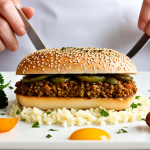Essential Components of a Classic Trifle
Understanding the classic trifle ingredients is essential for crafting an authentic dessert. The traditional trifle layers are composed of sponge cake, fruit, jelly, custard, and cream. Each classic dessert component plays a vital role in achieving the iconic texture and flavor balance.
The sponge cake serves as the base, typically soaked with sherry or fruit juice to provide moisture without sogginess. Use approximately 200 grams of sponge fingers or cubed cake for a standard 1.5-liter trifle bowl. Fresh or preserved fruits such as raspberries, strawberries, or peaches add the tartness and slight acidity essential to complement the richness of custard and cream.
Also to read : How Can British Cuisine Be Innovated for a Modern Twist?
Jelly, usually a clear fruit flavor like raspberry or strawberry, helps structure the layers while adding a sweet, fruity note. Prepare about 250 ml of jelly, allowing it to partially set before assembling to prevent mixing with the cake.
The custard should be thick and creamy—traditionally homemade from eggs, sugar, and milk. Approximately 300 ml of custard is recommended. Finally, a generous layer of softly whipped cream crowns the trifle, providing lightness and a smooth finish. This layering ensures the classic trifle ingredients work harmoniously, delivering both texture and taste true to the dessert’s heritage.
Also read : How can you make a flavorful Lancashire hotpot at home?
Essential Components of a Classic Trifle
Understanding the classic dessert components is key to making an authentic trifle that delights both the eye and palate. A traditional trifle consists of layered elements, each serving a specific role in texture and flavor.
The traditional trifle layers start with the sponge, which absorbs sherry or another liquid. Use a light, airy sponge cake—preferably plain or Madeira—to soak up moisture while maintaining structure. Next comes the fruit, often a mix of berries or seasonal selections, providing bright tartness and freshness.
Jelly, usually made from fruit-flavored gelatin, forms the third layer and adds a vibrant, translucent element that contrasts with other textures. Custard follows, offering rich, creamy softness. It should be thick enough to hold its shape but still smooth.
Finally, a generous layer of whipped cream tops the dessert, lending a lightness that balances the richness beneath.
For ingredient quantities, a typical classic trifle uses about 200g of sponge, 300g of mixed fruit, 250ml of jelly, 400ml of custard, and 300ml of cream. Choosing fresh, quality ingredients for each layer ensures authenticity and an unmatched flavor profile.
Step-by-Step Traditional Trifle Recipe
A step-by-step trifle approach begins with gathering all the classic trifle ingredients in precise quantities. For a standard 1.5-liter trifle bowl, measure approximately 200 grams of sponge cake, preferably soaked in sherry or fruit juice. Use about 250 ml of clear fruit jelly, partially set to avoid mixing, and prepare 300 ml of thick, creamy custard. Finish with a generous layer of softly whipped cream to complete the traditional trifle layers.
Start by placing the sponge cake cubes evenly on the bottom of the serving dish, ensuring even soaking. Next, spoon the partially set jelly over the sponge, allowing it to fill gaps but not overflow. Follow with a layer of fresh or preserved fruit selected for tartness and color contrast. The custard layer goes on next, spread smoothly to cover the fruit without disturbing lower layers. Finally, crown the dessert with whipped cream, spreading it gently for a soft, airy finish.
Timing is crucial: allow the jelly to set partially before assembly, and chill the completed trifle for at least 4 hours. This resting period helps the classic dessert components meld, ensuring each layer maintains its distinct texture and flavor while the dessert chills to perfection.
Essential Components of a Classic Trifle
The classic trifle ingredients must harmonize to create a balanced dessert. The foundation is the sponge cake, light and porous, which soaks up moisture—often sherry or fruit juice—without losing texture. The sponge should measure about 200 grams to accommodate a typical trifle bowl.
Next, the fruit layer introduces fresh acidity and flavor contrast. Choose approximately 300 grams of mixed seasonal berries or stone fruits, ensuring a vibrant tartness that cuts through the dessert’s richness. Jelly follows, generally a clear fruit-flavored gelatin, around 250 milliliters. It sets firmly enough to separate layers without blending into adjacent components, preserving the traditional trifle layers’ distinct look and mouthfeel.
Custard, ideally 400 milliliters, must be thick but smooth, enveloping the sponge and fruit with its creamy texture. This layer is crucial for balance, delivering richness without overwhelming sweetness. Finally, about 300 milliliters of softly whipped cream tops the trifle, providing an airy contrast to the denser custard and cake.
Selecting fresh, high-quality ingredients for these classic dessert components ensures the trifle achieves its hallmark combination of textures and authentic flavors true to the tradition.
Essential Components of a Classic Trifle
The classic trifle ingredients form a harmonious blend, each contributing to the dessert’s signature taste and texture. The foundation starts with the sponge layer, typically 200 grams of light sponge cake soaked in sherry or fruit juice. This step ensures moisture without sogginess, providing a soft yet structured base.
Next, fruit adds a refreshing tartness that balances richness. Choose about 300 grams of berries or stone fruits, offering both color and acidity crucial for flavor contrast. Following this, around 250 ml of jelly, usually a clear fruit flavor, partially sets to create a firm, yet gentle layer that holds the ingredients together.
The custard layer, about 300-400 ml, must be thick but silky, achieved traditionally with eggs and milk for authenticity. This creamy component enriches the trifle but should not overwhelm other flavors. Lastly, a generous 300 ml layer of softly whipped cream completes the dessert, lending lightness and a smooth finish.
By carefully selecting and layering these classic dessert components within the traditional trifle layers, the dessert achieves its iconic balance of textures and flavors, essential for a truly classic trifle experience.
Essential Components of a Classic Trifle
The classic trifle ingredients create distinct layers, each contributing to the dessert’s signature harmony. The traditional trifle layers include sponge, fruit, jelly, custard, and cream, each with unique qualities essential for authenticity.
Start with the sponge, preferably a light, airy cake like Madeira or sponge fingers, absorbing about 200 grams worth of sherry or juice without becoming soggy. The fruit layer, roughly 300 grams, should be fresh or preserved berries or stone fruits; these classic dessert components introduce brightness and tartness that cut through the dessert’s richness.
Jelly, around 250 milliliters, must be partially set to maintain clear separation and structure between layers, adding a sweet, colorful visual contrast. The custard layer, about 300 to 400 milliliters, should be thick and creamy, achieving the right firmness without heaviness to wrap the fruit and sponge in smooth richness.
Finally, around 300 milliliters of softly whipped cream finishes the trifle, providing lightness and an airy mouthfeel. Selecting quality ingredients in proper quantities ensures an authentic trifle, where each traditional trifle layer performs its balancing role effectively.
Essential Components of a Classic Trifle
The classic trifle ingredients create a layered dessert where each element must meet key criteria for authenticity. Begin with the sponge layer, approximately 200 grams of light, airy sponge cake that efficiently absorbs moisture—usually sherry or fruit juice—without becoming soggy. This provides the essential structural base for the traditional trifle layers.
Following the sponge, the fruit layer typically involves around 300 grams of fresh or preserved berries or stone fruits. These contribute natural tartness and vibrant color, essential for balancing the rich custard and cream. Next, the jelly, about 250 ml, should be partially set before assembly—firm enough to maintain clear separation between layers without blending, preserving the distinctive visual and textural contrast characteristic of classic dessert components.
The custard layer, ideally 300 to 400 ml, must be thick, smooth, and creamy. A well-prepared custard envelops the fruit and sponge, enriching the dessert with delicate sweetness and silky texture. Finally, the cream topping, roughly 300 ml of softly whipped cream, adds lightness and a velvety finish. Selecting fresh, high-quality ingredients and paying attention to these quantities ensures the iconic balance in traditional trifles.
Essential Components of a Classic Trifle
The classic trifle ingredients create a layered dessert where each element plays a precise role in texture and flavor. The traditional trifle layers begin with the sponge cake, about 200 grams, selected for its ability to absorb liquids such as sherry or fruit juice without becoming soggy. This base supports the subsequent layers structurally and adds a subtle moistness.
Next, roughly 300 grams of fresh or preserved fruit introduces vital acidity and brightness, balancing the sweetness of other components. Following fruit, the jelly layer—around 250 milliliters—needs to be partially set before assembly to ensure it holds its shape and distinct separation within the dessert. This layer adds a sweet, translucent color and firmness.
The custard, typically 300 to 400 milliliters, must be thick yet smooth, enveloping the sponge and fruit to provide rich creaminess without overwhelming the palate. Lastly, approximately 300 milliliters of softly whipped cream tops the classic dessert components, creating an airy contrast that finishes the trifle with lightness.
Selecting high-quality ingredients and adhering to these quantities ensures the traditional trifle layers blend authentically, balancing texture and flavor harmoniously in a classic trifle.
Essential Components of a Classic Trifle
The classic trifle ingredients form a layered dessert built on five essential components: sponge, fruit, jelly, custard, and cream. Each part must be carefully selected and measured to preserve authenticity and balance. A typical trifle includes about 200 grams of light sponge cake, which absorbs moisture—usually sherry or fruit juice—without becoming soggy. The sponge acts as the foundational layer in the traditional trifle layers.
Next is the fruit layer, generally around 300 grams of mixed berries or stone fruits. This contributes freshness and acidity, key for offsetting the richness of custard and cream. Jelly, approximately 250 milliliters of clear fruit-flavored gelatin, should be partially set before layering to maintain separation and structure among the classic dessert components.
Custard occupies about 300 to 400 milliliters, ideally thick and creamy but not overly sweet, to envelop the fruit and sponge smoothly. Lastly, roughly 300 milliliters of softly whipped cream finishes the trifle, offering lightness and a silky texture.
Attention to ingredient quality and precise traditional trifle layers quantities ensures the dessert’s iconic harmony of flavors and textures remains intact.
Essential Components of a Classic Trifle
The classic trifle ingredients combine in five distinct traditional trifle layers: sponge, fruit, jelly, custard, and cream. Each layer’s selection and preparation are crucial for an authentic experience.
The foundation is about 200 grams of light sponge cake, chosen for its porous texture to absorb sherry or fruit juice without sogginess. This sets the structural base and moistness. Next, roughly 300 grams of fresh or preserved fruit, usually berries or stone fruits, adds freshness and a necessary tart contrast to balance richness.
For the jelly, use around 250 milliliters of clear fruit-flavored gelatin. Partial setting before layering ensures it maintains separation and structure within the dessert. Custard follows, with 300 to 400 milliliters of thick, smooth custard, traditionally homemade with eggs and milk. It enriches the layers without overwhelming sweetness or heaviness.
Finally, about 300 milliliters of softly whipped cream tops the trifle, lending lightness and a velvety finish. Selecting high-quality classic dessert components and respecting these quantities ensures the ideal blend of textures and flavors that define a classic trifle’s authenticity.
Essential Components of a Classic Trifle
The classic trifle ingredients are organized into five key traditional trifle layers: sponge, fruit, jelly, custard, and cream. Each component must fulfill specific qualities to preserve authenticity and ensure the ideal taste and texture balance.
Begin with about 200 grams of sponge cake—light and airy, capable of absorbing sherry or fruit juice without turning soggy. This base provides structure to the dessert. The fruit layer usually involves roughly 300 grams of fresh or preserved berries or stone fruits, delivering necessary tartness and brightness that counterbalance the richness of custard and cream.
Next, 250 milliliters of jelly partially set maintains distinct separation between the layers, adding a translucent, firm texture that visually and texturally contrasts with the other classic dessert components. The custard layer, between 300 to 400 milliliters, should be thick yet smooth, rich but not overly sweet, enveloping the sponge and fruit seamlessly.
Finally, approximately 300 milliliters of softly whipped cream creates an airy finish, lending lightness to the dessert. Proper selection and layering of these ingredients within the traditional trifle layers framework is essential for crafting an authentic classic trifle.










